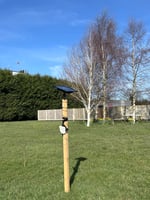Project Duration: 24 Months September 2023 to August 2025. Project Partners: UK ATC, AgriSound,...
Dole Precision Pollination
 Global fruit producer Dole UK has partnered with agri-tech innovator AgriSound to launch a UK-based pilot study focused on pollination and fruit production.
Global fruit producer Dole UK has partnered with agri-tech innovator AgriSound to launch a UK-based pilot study focused on pollination and fruit production.
Project Duration:
The pilot runs from April to October 2025.
Project Location:
Kent, UK
Objective:
To assess how advanced growing materials—specifically SecondSky thermal reduction polytunnel covers from IYRIS—affect pollinator activity and ultimately impact fruit yield and quality.
Technology:
AgriSound’s Polly™ sensors are being used to capture real-time pollinator data (with a focus on bumblebee activity) under different tunnel conditions. The study will specifically investigate the impact of IYRIS (a leading global producer of adaptive agri-climate products) SecondSky thermal reduction polytunnel covers on tunnel microclimates and bumblebee activity, comparing them to industry-standard materials.
Significance:
🐝 Provides insights into the ecological and commercial impacts of farming innovations.
🐝 Bridges the gap between on-farm trials and large-scale agricultural deployment.
🐝 Supports smarter R&D for improved yield, sustainability, and ecosystem protection.
Industry Context:
This project aligns with a broader trend of increased investment in agri R&D in the UK, with over £800 million spent between 2021–2022.
Impact Goals:
🐝 Quantify the impact of new growing materials on pollination.
🐝 Validate sustainable innovations before large-scale implementation.
🐝 Enhance Dole’s ability to make data-driven, environmentally conscious decisions in fruit production.
“This project is not just about testing a new material, it’s about understanding the broader ecological and commercial impacts of farming innovations, especially in the fruit industry.
“At Dole, we’re always looking for the opportunity to improve our sustainable practices across our sites. By partnering with AgriSound for this pilot study, we can see the real-time influence of our decision-making when it comes to our standard practices and determine exactly how we can better protect the local ecosystems and pollinators.”



